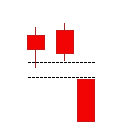Table of Contents
Below the Neckline – Bullish Atekubi
Definition
A bullish atekubi (line below the neckline) is a structure comprised of two Japanese candlesticks.
The first candlestick is a large bullish candlestick (green), followed by a small bearish candlestick (red) with a closing just above the closing level of the previous candlestick.
The second candlestick must be significantly smaller than the first.
Illustration
Characteristic
A bullish atekubi often forms after a significant increase characterized by several large green Japanese candlesticks.
Significance
A line under the neckline (bullish atekubi) is a continuation pattern, indicating a continuation of the bullish movement.
Note
For the structure to be validated, the next candlestick must be bullish and close above the opening level of the small bearish candlestick (red).
Invalidation
If the lowest point of the small bearish candlestick surpasses the next candlestick, the structure can be considered invalidated.
Below the Neckline – Bearish Atekubi
Definition
A bearish atekubi (line below the neck) is a structure comprised of two Japanese candlesticks.
The first candlestick is a large bearish candlestick (red), followed by a small bullish candlestick (green) with a closing just below the closing level of the previous candlestick.
The second candlestick must be significantly smaller than the first.
Illustration
Characteristic
A bearish atekubi often forms after a significant decline characterized by several large red Japanese candlesticks.
Significance
A line below the neckline (bearish atekubi) is a continuation pattern, indicating a continuation of the bearish movement.
Note
For the structure to be validated, the next candlestick must be bearish and close below the opening level of the small bullish candlestick (green).
Invalidation
If the highest point on the small bullish candlestick surpasses the next candlestick, the structure can be considered invalidated.
Concluding Thoughts
The bullish and bearish atekubi patterns are valuable continuation signals within a trending market.
They provide insight into the potential for ongoing momentum in the direction of the current trend, offering traders opportunities to position themselves accordingly.
However, as with all candlestick patterns, confirmation from subsequent candlesticks and additional technical indicators is crucial to ensure the reliability of the signal and to avoid false setups.









